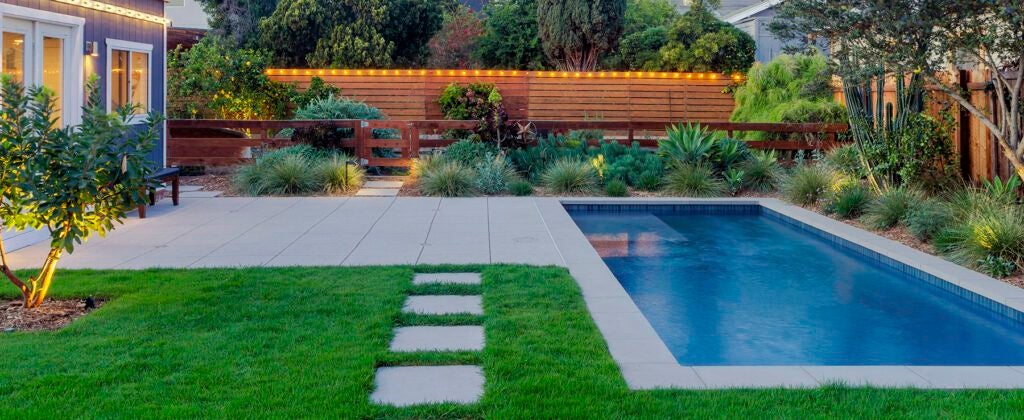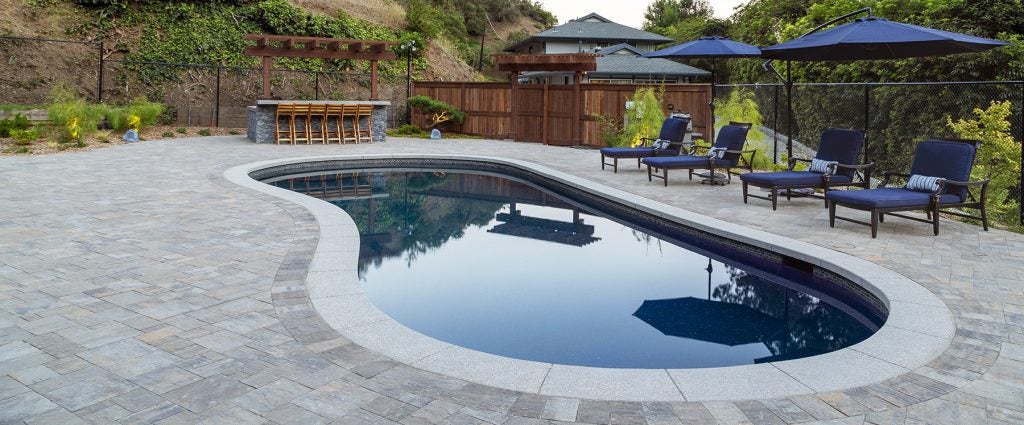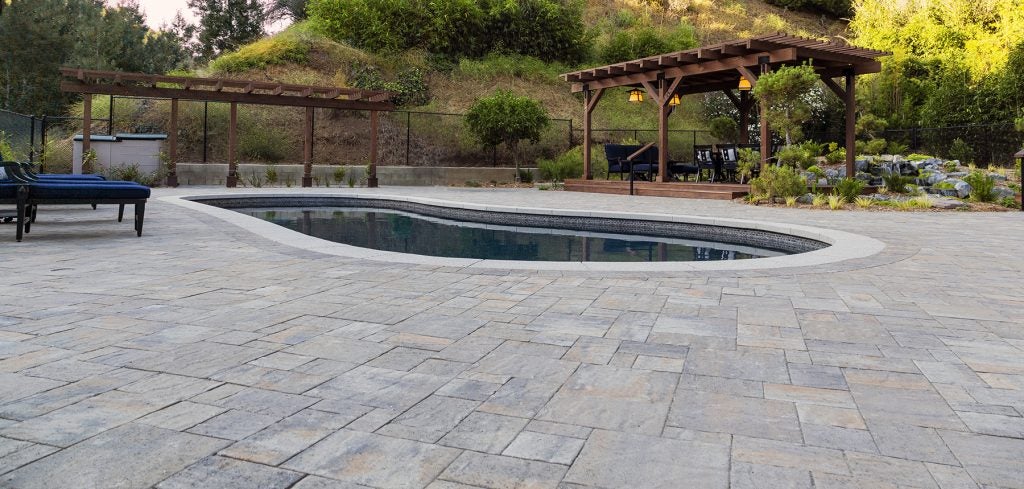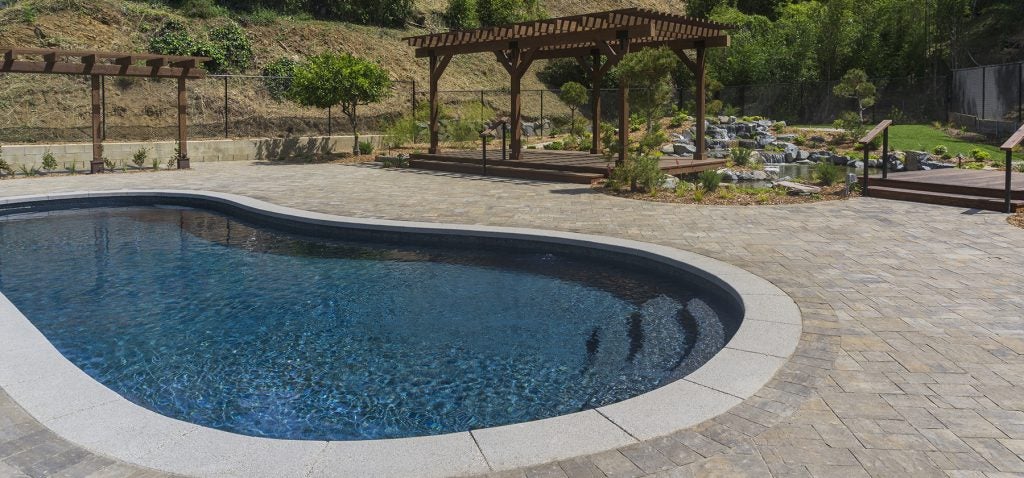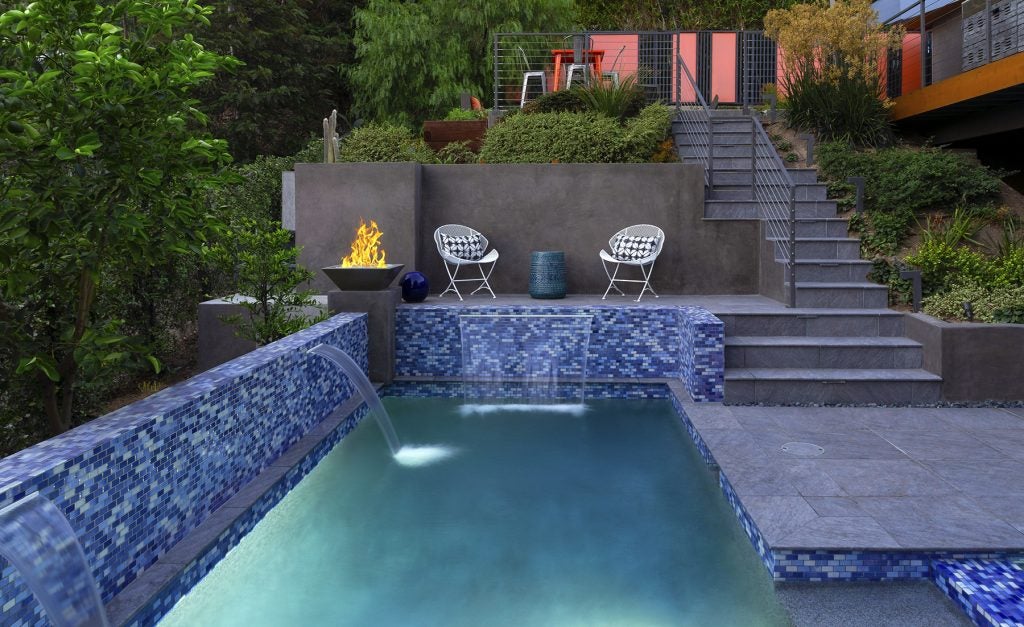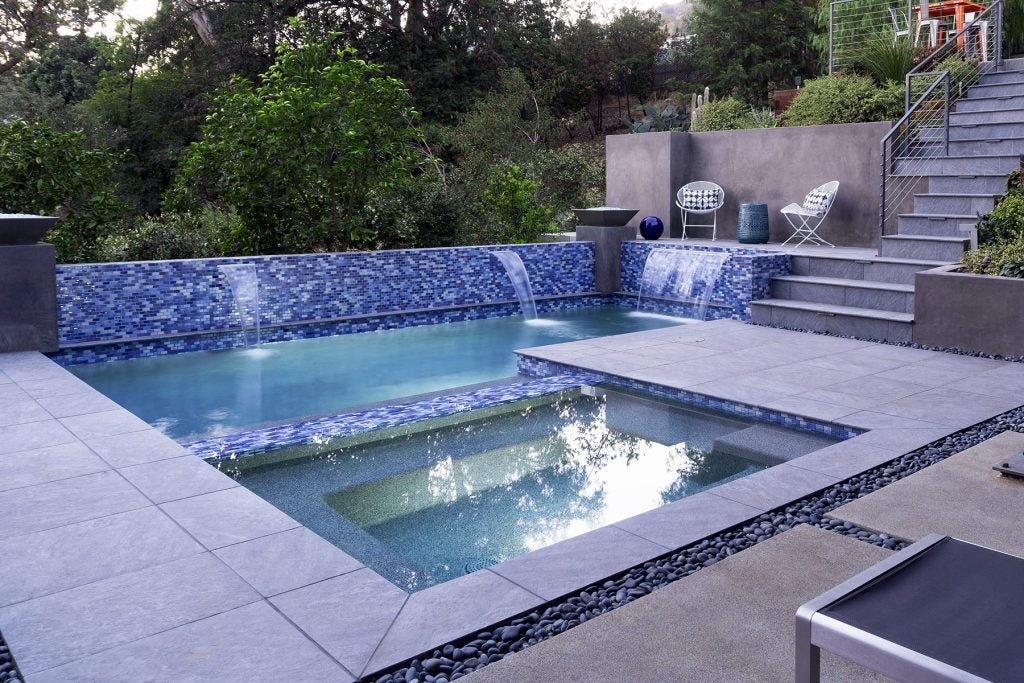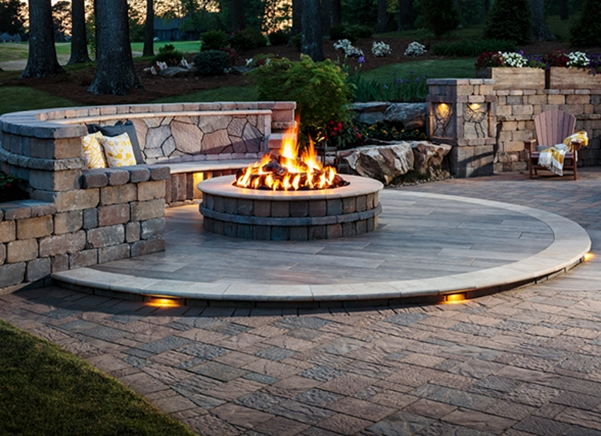If you’re looking to build a pool and pool deck or remodel an existing one, it’s crucial that you choose your materials before breaking ground. For decades concrete has been the leading material for pool decks, but in just a few years paving stones have made a significant impact in the pool deck world for their numerous benefits over their predecessor.
Below, we have listed the four main factors to consider before choosing a paving material and how each material stacks up. By the end of this article, you should have the knowledge to make an informed decision on what material is right for you.

. . .
Pool Deck Slip Resistance / Slip Coefficient
When choosing the best material for your pool deck, safety is the most important factor to consider. With any body of water such as pools, there are inherent hazards that need to be planned for. That is why choosing the most slip resistant, or slip
coefficient, option is crucial. With the two most popular pool deck options being paving stones and concrete, let’s see how they compare.
By design, paving stones are inherently more porous and denser than concrete. Most paving stones are made by combining sand, water, cement mixture and color pigment, then pouring the mixture into a mold. This means that on a molecular level, paving
stones have a more complex surface than regular concrete, making them an excellent source for traction. Paving stones also have a smaller surface area than concrete slabs and when installed in an interlocking pattern, they give an added level of slip resistance.
Not only is concrete less porous and therefore less slip resistant, its also poses another huge hazard. From the very first use, concrete starts to wear down. The more you use the area, the more worn it gets, causing slick spots in high traffic areas. This
poses a major slipping hazard for kids and adults alike. Unfortunately, there is no solution for this issue other than replacing your entire pool deck, which can be very costly. On top of that, slick spots in the surface of your pool deck creates an unsightly
unevenness that can take away from your pool’s aesthetic.
Pool Deck Aesthetics
Not only are paving stones the better choice in terms of safety, they are also the most versatile pool deck material. Due to the thousands of variations, paving stones can lend themselves to all design styles, from rustic to ultra-modern. Paving stones can be made to replicate natural stone or be created in larger stones to compliment a sleeker aesthetic. Pavers also come in a variety of colors and can easily be paired with your home’s style. To add another layer of customization, you can also mix and match different shapes, colors and stones to create ornate patterns in your design.
Concrete, on the other hand, has very little customization options. Once concrete cracks (and it’s only a matter of time before it does crack) it is very unsightly. Cracks in concrete are also much more noticeable when wet, which means every time you use
your pool it becomes an eyesore instead of a focal point. Compared to its concrete counterpart, paving stones are a designer’s best friend.
Durability
Strength plays an integral role in the durability of pool deck materials. When talking about the strength of the materials, paving stones can handle around 8,000 PSI (or pounds per square inch) of pressure, as opposed to concrete which can hold around
3,500 PSI. This makes a notable difference if you are planning on adding heavy patio furniture, prefabricated outdoor kitchens or hosting guests on your pool deck.
One thing that both pavers and concrete have are a curing process, which is a time that the materials need to reach their maximum strength. However, an advantage to paving stones is that their curing process is done in a temperature-controlled factory where
they go through a variety of safety tests. Concrete, on the other hand, is poured in your backyard and is left to cure, making it open to environmental changes.
Concrete slabs can also be very temperamental. Not only are they susceptible to cracking from improper weight disbursement, they are also temperature sensitive and can crack due to significant changes in temperature. Once your concrete deck does
crack, it can pose a tripping hazard as well as possible drainage issues. Concrete can also crack due to ground movement. In California where we are located, the next earthquake is just around the corner, which can pose a costly problem. Paving stone pool
decks are installed with jointing sand in between each stone, which provides them with more flexibility when changes in ground movement or weight disbursement occur.
When it comes to durability, paving stones take the cake.
Paver Pool Deck Maintenance
Keeping your investment looking great year-round and which materials will make that easy on you are important factors to consider before starting your project. Maintenance required for paving stones is few and far between, especially if you get your pavers sealed after they’re installed. Paver sealer is a protective layer sprayed on to keep the stones stain-resistant, maintain their color and keep the joint sand from transferring. This means that if you spill a glass of wine, the kids drop their ice cream or
anything in between, your paving stone pool deck is protected and stain free. If, god forbid, a stain does happen on your paving stone pool deck, you simply replace the single stone or stones affected without having to replace the entire deck. The same
can’t be said if you go with the concrete counterpart.
Repairing concrete is an expensive hurdle. If a crack or stain stretches more than two inches in length, repairing it is not possible, and the entire slab may have to be replaced. Concrete has a low upfront cost but, in the end, proves to be an unruly,
expensive option for a high-traffic area such as a pool deck. Although paving stones are a few dollars more per square foot to install than concrete, the maintenance alone can end up saving you thousands of dollars.
When all is said and done, paving stones provide a much higher return on investment than traditional concrete. Whether you’re looking for a material that can emulate natural stone, a traditional aesthetic or something ultra-modern, paving stones have the customizability to give you exactly what you want.
Renovating an old pool deck or creating one from scratch is a big investment. Choosing paving stones means you will not only be going with the most aesthetically pleasing option; you will also be going with the safest and most durable one. Pacific Outdoor Living has installed thousands of pools decks across Southern California using Belgard’s quality paving stones. We pride ourselves on doing what is right for the homeowner and their budget. If you ask us, paving stones are the obvious choice.
